Warner Premiere Digital (2008), Warner Home Video (March 3, 2009), two discs, 325 mins plus supplements, 1.85:1 widescreen, Dolby Digital 5.1, Unrated (for mature audiences only), Retail: $29.98
Storyboard:
In an alternate version of the eighties in New York City, Nixon is serving his fifth term as president, America has won the war in Vietnam, the Cold War is at its most heated, costumed vigilantes have been outlawed, and a former vigilante, named Comedian, has been found murdered outside his apartment. In this world, another costumed vigilante named Rorschach investigates the murder while trying to convince his former colleagues that there is a wide conspiracy against them.
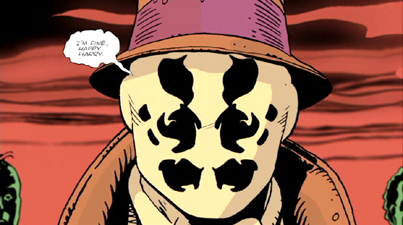
The Sweatbox Review:
In case you have not heard, Watchmen is considered to be the greatest graphic novel of all time, and actually one of the best novels of the century. The novel is supposed to have had a profound impact in the comic book world, paving the way for graphic novels that were more realistic and dark. I only recently read the novel and I can say that it is an excellent book, and even better on a second reading. The story is an analysis of the superhero concept and imagines it in a more realistic light, grounding the characters in our own world. It asks the question of how superheroes would actually be like if they lived in our world. What kind of person would don a mask and become a vigilante? In twelve brilliant chapters, writer Alan Moore, artist Dave Gibbons, and colorist John Higgins, create an alternate world at the brink of nuclear war where superheroes have been outlawed and the one person who can save the world doubts the value of saving humanity. Last year, in anticipation for the release of the movie in theaters, Warner Bros. Premiere Digital commissioned a series of motion comics, one for each chapter in the original novel to be distributed over the Internet. These episodes contained the original comic book designs with a narrator and minimal animation to simulate action. The result is a faithful adaptation of the novel that is sure to please fans of the original.
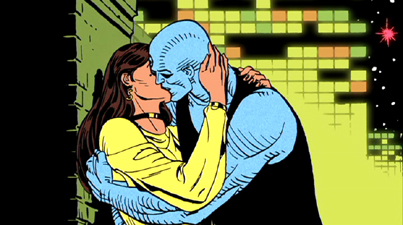
There are six main vigilantes in the story and each of them explores a different personality of superheroes. One of the most interesting aspects of Moore’s superheroes is that they are not particularly extraordinary. In fact, only one of the characters, Dr. Manhattan, actually has a superpower. The rest are fighting vigilantes are trained in combat, but have no other special ability. One of the main vigilantes in the story is Rorschach, who refused to give up vigilantism even after a law was passed to abolish them. Rorschach wears a white mask with black blots that move around his face, like a Rorschach test. Another main hero is Nite Owl II/Dan Dreiberg, a wealthy and intelligent middle-aged man who used to wear an owl costume when fighting crime. Another former vigilante is Ozymandias/Adrian Veidt, a billionaire philanthropist who owns his own corporate empire. The only female vigilante in the main story is the Silk Spectre/Laurie Juspecyzk, who took over the vigilante duties from her mother, the original Silk Spectre. In the beginning of the story, Laurie is the lover of Dr. Manhattan/Jonathan Osterman, the only hero with actual superpowers. Osterman became a superhero after being caught in a freak radioactive accident that allowed him to manipulate matter at a subatomic level. He was then hired by the U.S. government to help as a deterrent against the Russians during the Cold War. The final main character is The Comedian/Edward Blake, a ruthless and cynical vigilante that also works for the American government. Blake’s murder sets the story in motion in the first chapter and he is mainly seen through flashbacks throughout the story.
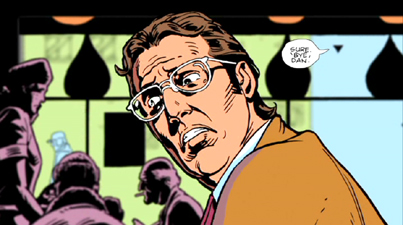
As mentioned, the story begins with the discovery of Edward Blake’s body on the sidewalk outside his building in New York City. Rorschach, investigating the murder suspects that he was murdered because he was a costumed vigilante. In his investigations, he questions a former costumed villain named Morloch who is dying of cancer. With nowhere else to go, Rorschach warns his former colleagues about his suspicions but they do not take him seriously. Later, Dr. Manhattan is ambushed by reporters accusing him of giving cancer to former colleagues and he disappears from the Earth. This event sets off a global crisis as the United States have lost their deterrent against the Soviet Union who is threatening to invade Pakistan. The conspiracy continues when Adrian Veidt suffers an assassination attempt. Rorschach shares his discoveries and suspicions with his former partner, Nite Owl II, who does not believe him. In the meantime, Laurie’s relationship with Dr. Manhattan has deteriorated and she begins a new relationship with Dreiberg. Rorschach also begins to suspect that he might be the next target.
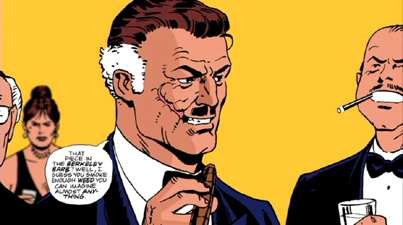
As the story unfolds, we begin to see these characters as full-rounded individuals. We eventually see Rorschach’s backstory as a deeply troubled individual driven by revenge and with the inability to see the gray areas in life. We also get to see Dreiberg as more of a disappointed optimist who wanted to be like his hero, the original Nite Owl. He also seems to have a costume fetish and a fixation with birds. We learn that Laurie never wanted to be a costumed vigilante and was pushed into the position by her mother, the original Silk Spectre. The Comedian comes off as a sadistic and nihilistic individual who hurt more people than he helped. As we get to know Ozymandias, we realize that his intelligence level has led him to sort of look down on the rest of humanity. Finally, Dr. Manhattan, becomes the most complex individual. He seems like the type of man that is slowly losing his human side. He seems to be an emotionally withdrawn scientist with a god complex. Dr. Manhattan lives in both the past and present and has several visions of what is happening in the future. It is said that when Moore created the characters, he wanted to give readers a different ways of seeing the world and let the readers decide which way was right and which was wrong. In the end, we get to see both sides of each argument from each individual character, making the book a fascinating character study on humanity.
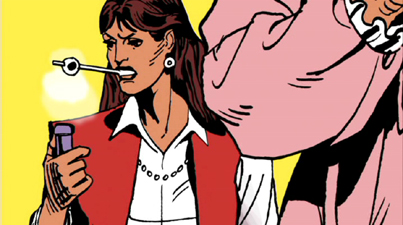
By now, the live-action adaptation of the book has come out and the reviews decidedly mixed. For years, fans of the original novel have deemed this story to be unfilmable. There were many reasons for this, including the length of the story and the sometimes poetic juxtapositioning of images and words that would be difficult to pull off on the big screen. There is an entire story within the story called Tales of the Black Freighter that is paralleled in action throughout the book and while it reads perfectly in the book, it is difficult to translate onscreen. This entire story is actually completely missing from the live-action adaptation, removing some of the subtext of the story. In the end, what is most difficult is turning the self-containing chapters into one seamless narration. Terry Gilliam, once attached to the project, once suggested turning the entire novel into a miniseries, but this also did not materialize. Each chapter deals with a particular theme, focusing on just a few characters at a time. They are mean to be appreciated on their own and this is where this motion comic succeeds.
By keeping the entire comic book basically intact, the motion comic will undoubtedly become the most faithful adaptation of the novel. The only parts of the novel not included in this story are the book excerpts, articles, and letters usually found at the end of each chapter. These were created by Moore to fill up some ad space in the end of each issue when they were first released by DC Comics. The animation in these episodes is limited. The exact frames of the comic book are used with minimal animation, usually restricted to the character’s eyes or limbs moving slight in each frame. Instead of walking, the characters just move across the screen as if they are cartoon cutouts from the novel. With minimal, yet effective, sound effects, and with one principal narration, the story moves quickly through the entire length of the novel. Overall, the story retains the beauty of the graphics and the poetic writing of the original novel.

The episodes are divided as follows:
Disc One
1. At Midnight, All the Agents…
2. Absent Friends
3. The Judge of All the Earth
4. Watchmaker
5. Fearful Symmetry
6. The Abyss Gazes Also
Disc Two
1. A Brother to Dragons
2. Old Ghosts
3. The Darkness of Mere Being
4. Two Riders Were Approaching…
5. Look on My Works, Ye Mighty…
6. A Stranger Loving World
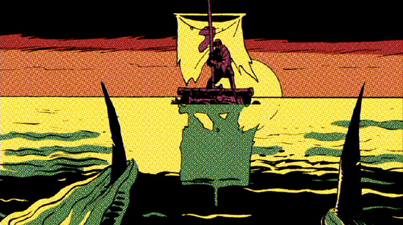
Is This Thing Loaded?
With each disc loaded with the six chapters of the story, and with a storyline exceeding five hours, there is little room for bonus features. However, Warner Bros. does use this release to promote some of their more recent DC Comics offerings. The first disc comes with advertising for some of Warner’s Blu-Ray offerings. Of course, we are also treated to a trailer for the live-action Watchmen movie and the new accompanying video game. Finally, we are treated to a trailer for the new Wonder Woman animated movie. Surprisingly, these trailers cannot be accessed from the main menu.
At the beginning of the second disc, we are treated to a preview of the DVD release for Watchmen: Tales of the Black Freighter animated feature (which also features Hollis Mason’s “Under the Hood”). Finally, the one true special feature on this DVD set is the Wonder Woman Sneak Peek (10:25) which takes us behind the scenes of the latest animated film from DC Comics. It is an interesting promo for the movie and I have to admit got me excited to see it.
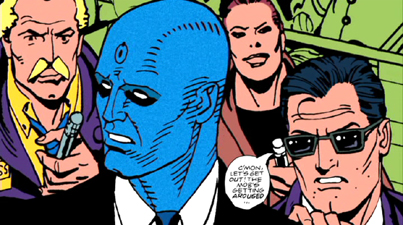
Case Study:
Watchmen: The Complete Motion Comic comes in a standard, black two-disc keepcase. Inside, there are three inserts. One is for Warner Blu-Ray titles. A second insert promotes Watchmen books and video games. Finally, for fans interested in watching the live-action movie, there is a $7.50 coupon to watch the movie in participating theatres (Expires March 28, 2009).
Ink And Paint:
The shorts were produced by Cruel & Unusual in partnership with Lawrence Gordon/Lloyd Levin Productions, who also produced the live-action films (and the recent Hellboy movies). The animation, in this case, was done by San Francisco-based Juice Films who have done an amazing job at adapting comic books into motion comics. Directed by Jake S. Hughes, the animation is really brings the comic book to life while being faithful to the original designs by Dave Gibbons. In fact, Gibbons actually served as a consultant for the episodes. As mentioned, the original comic book frames are used in the episodes with minimal animation to create motion. The episodes are each featured in a 1.85:1 widescreen aspect ratio.

Scratch Tracks:
The original dialogue bubbles from the comics are still featured in the episodes, but here we get a narrator, Tom Stechschulte, doing all of the voices in the book. There is also some background music provided by Lennie Moore. I was initially concerned about having one narrator doing the voices for the characters, including the female voices, but after a while I got used to it and actually enjoyed his narration. Stechschlute does a great job at bringing the character’s emotions out of the page. I actually found myself reading along with the narrator in many of the scenes. There were a few reading errors here and there, but they were minimal and did not change anything (mostly some words that were reversed in order from the original dialogue). The sound is provided here in an excellent Dolby Digital 5.1 track. It is only found in English, and there are English subtitles included for the hearing impaired.

Final Cut:
Overall, the motion comic does an incredible job of bringing this classic graphic novel to life. For fans who have never watched a motion comic in the past, I would recommend starting out with this one. I have the feeling that they will gradually become more popular in the future. In my opinion, this episodic format is the most appropriate to bringing the story to life. As for the actual story, this is truly one of the best graphic novels of our lifetime. The characters are well-rounded and the way it explores humanity’s darkest characteristics is thought-provoking. Overall, this release is great for new and old fans of the novel. For those who cannot bother to sit and read the whole thing, this is also a great alternative (although I still urge you to read the original).

Please note that I tried to stay away from the film before writing this review so I would not be influenced by my feelings for the movie.
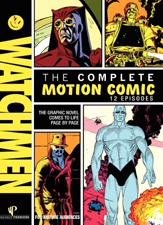 | ||
 |






